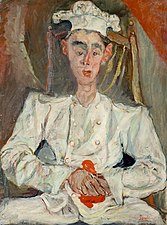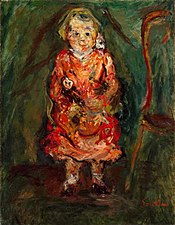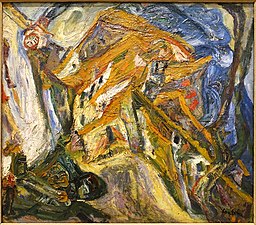art.wikisort.org - Artist
Chaïm Soutine (13 January 1893 – 9 August 1943) was a Belarusian[1] painter who made a major contribution to the expressionist movement while living and working in Paris.[2]
Chaïm Soutine | |
|---|---|
 Chaim Soutine (with signature) | |
| Born | Chaim-Iche Solomonovich Sutin (Хаим-Иче Соломонович Сутин) 13 January 1893 Smilavičy, Minsk Governorate, Russian Empire (now Belarus) |
| Died | 9 August 1943 (aged 50) Paris, France |
| Education | Vilna Academy of Fine Arts, École des Beaux-Arts, Fernand Cormon |
| Known for | Painting |
| Movement | Expressionism |
| Patron(s) | Albert C. Barnes, Leopold Zborowski |
Inspired by classic painting in the European tradition, exemplified by the works of Rembrandt, Chardin[3] and Courbet, Soutine developed an individual style more concerned with shape, color, and texture than representation, which served as a bridge between more traditional approaches and the developing form of Abstract Expressionism.
Early life
Soutine was born Chaim-Iche Solomonovich Sutin, in Smilavičy in the Minsk Governorate of the Russian Empire (present-day Belarus). He was Jewish[4] and the tenth of eleven children born to parents Zalman (also reported as Solomon and Salomon) Moiseevich Sutin (1858–1932) and Sarah Sutina (née Khlamovna) (died in 1938).[5][6] From 1910 to 1913 he studied in Vilnius at a small art academy.[7] In 1913, with his friends Pinchus Kremegne and Michel Kikoine, he emigrated to Paris, where he studied at the École des Beaux-Arts under Fernand Cormon. He soon developed a highly personal vision and painting technique.
Career
For a time, he and his friends lived at La Ruche, a residence for struggling artists in Montparnasse where he became friends with Amedeo Modigliani. Modigliani painted Soutine's portrait several times, most famously in 1917, on a door of an apartment belonging to Léopold Zborowski, who was their art dealer.[8] Zborowski supported Soutine through World War I, taking the struggling artist with him to Nice to escape the possible German invasion of Paris.
After the war Paul Guillaume, a highly influential art dealer, began to champion Soutine's work. In 1923, in a showing arranged by Guillaume, the prominent American collector Albert C. Barnes, bought 60 of Soutine's paintings on the spot. Soutine, who had been virtually penniless in his years in Paris, immediately took the money, ran into the street, hailed a Paris taxi, and ordered the driver to take him to Nice, on the French Riviera, more than 400 miles away.
Carcass paintings
Soutine once horrified his neighbours by keeping an animal carcass in his studio so that he could paint it (Carcass of Beef). The stench drove them to send for the police, whom Soutine promptly lectured on the relative importance of art over hygiene. There's a story that Marc Chagall saw the blood from the carcass leak out onto the corridor outside Soutine's room, and rushed out screaming, "Someone has killed Soutine."[9] Soutine painted 10 works in this series, which have since become his most well-known. His carcass paintings were inspired by Rembrandt's still life of the same subject, Slaughtered Ox, which he discovered while studying the Old Masters in the Louvre. Soutine produced the majority of his works from 1920 to 1929. From 1930 to 1935, the interior designer Madeleine Castaing and her husband welcomed him to their summer home, the mansion of Lèves, becoming his patrons, so that Soutine could hold his first exhibition in Chicago in 1935. He seldom showed his works, but he did take part in the important exhibition The Origins and Development of International Independent Art held at the Galerie nationale du Jeu de Paume in 1937 in Paris, where he was at last hailed as a great painter.
German invasion
Soon afterwards France was invaded by German troops. As a Jew, Soutine had to escape from the French capital and hide to avoid arrest by the Gestapo. He moved from one place to another and was sometimes forced to seek shelter in forests, sleeping outdoors.
Illness and death
Suffering from a stomach ulcer and bleeding badly, Soutine left a safe hiding place for Paris for emergency surgery, which failed to save his life. On 9 August 1943, he died of a perforated ulcer. He was interred in Cimetière du Montparnasse, Paris.
Legacy

In February 2006, an oil painting of his controversial and iconic series Le Bœuf Écorché (1924) sold for a record £7.8 million ($13.8 million) to an anonymous buyer at a Christie's auction held in London—after it was estimated to fetch £4.8 million. In February 2007, a 1921 portrait of an unidentified man with a red scarf (L'Homme au Foulard Rouge) sold for $17.2 million—a new record—at Sotheby's London auction house. In May 2015, Le Bœuf, circa 1923, oil on canvas, achieved a record price for the artist of $28,165,000 at the Christie's curated auction Looking forward to the past.
One of the beef paintings, known as Le boeuf, was sold for $1 million in 2004 and resold six months later for twice that price to the National Gallery of Art in Washington, D.C.. Heirs of the first seller sued to have the painting returned, claiming the price was unfairly low, and a complex settlement in 2009 required the painting to be transferred to them.[10]
Roald Dahl placed him as a character in his 1952 short story "Skin".[11]
The Jewish Museum in New York has presented major exhibitions of Soutine's work in An Expressionist in Paris: The Paintings of Chaim Soutine[12] (1998) and Chaim Soutine: Flesh (2018).[13]
In 2020, Soutine's painting Eva became a symbol of pro-democracy protests in Belarus.[14][15]
Gallery
Portraits and figures
- Self Portrait (1918) oil on canvas, 21.5 × 18 in., Henry and Rose Pearlman Collection, on long-term loan to the Princeton University Art Museum
- The Idiot (c. 1920) oil on canvas, 36.2 × 25.5 in., Calvet Museum, Avignon
- Farm Girl (1922) oil on canvas, 31.5 × 17.5 in., collection unknown
- The Little Pastry Chef (1922–23) oil on canvas, 73 × 54 cm, Musée de l'Orangerie, Paris
- Woman in Pink (c. 1924) oil on canvas, 73 × 54.3 cm., Saint Louis Art Museum
- Portrait Of A Man With A Felt Hat (1924) oil on canvas, 36 × 28 in., collection unknown
- Young Girl with a Doll (1926–1927) oil on canvas, 25.5 × 19.5 in., Museum of Fine Arts, Houston
- Portrait of Madeleine Castaing (c. 1929) oil on canvas, 100 × 73 cm., Metropolitan Museum of Art, New York
- Female Nude (1933) oil on canvas, 18 × 10.5 in., collection unknown
Still Lifes
- The Table (c. 1923) oil on canvas, 35.8 x 39.3 in., Musée de l'Orangerie, Paris
- Still Life with Rayfish (c. 1924) oil on canvas, 32 × 39.5 in., Metropolitan Museum of Art, New York
- Still life with Pheasant (c. 1924) oil on canvas, dimensions unknown, Musée de l'Orangerie, Paris
- Chicken Hung Before a Brick Wall (1925) oil on canvas, dimensions unknown, Kunstmuseum Bern, Switzerland
- The Plucked Chicken (c. 1925), oil on canvas, dimensions unknown, Musée de l'Orangerie, Paris
- Hanging Turkey (c. 1925) oil on millboard, dimensions unknown,
- Carcass of Beef (c. 1925), oil on canvas, 53 × 32 in., Albright-Knox Art Gallery, Buffalo, New York
Landscapes
- Chemin de la Fontaine des Tins at Céret, c. 1920, Henry and Rose Pearlman Collection on long-term loan to the Princeton University Art Museum
- Chemin de la Fontaine Fils à Céret (1920) details unknown
- View of Céret (c. 1921–22) oil on canvas, Henry and Rose Pearlman Foundation on long-term loan to the Princeton University Art Museum
- Steeple of Saint-Pierre at Céret, c. 1922, Henry and Rose Pearlman Foundation on long-term loan to the Princeton University Art Museum
- Landscape with Figures-Céret (1922) oil on canvas, dimensions unknown, High Museum of Art, Atlanta
- View of Cagnes (c. 1924 –25) oil on canvas, 23.7 × 28.8 in., Metropolitan Museum of Art, New York
- Return From School (c. 1939) oil on canvas, 18 × 19.75 in., The Phillips Collcetion, Washington, D. C.
Footnotes
- "Chaim Soutine – 119 artworks – painting".
- Getty Research Institute: Union List of Artist Names Online. Retrieved 20 June 2020.
- Kleeblatt, 13
- By Norman Kleeblatt, September 14, 2018, Hyperallergic
- "Sarah Sutina". geni_family_tree. Retrieved 2020-10-19.
- "Salomon Sutin". geni_family_tree. Retrieved 2020-10-19.
- Giraudon, Colette (2003). "Soutine, Chaïm". Grove Art Online.
- Kleeblatt et al., 101
- Wullschlager, Jackie (2008). Chagall - Love and Exile. Allen Lane. p. 154. ISBN 978-0-7139-9652-4.
- Mitchell Martin (1 June 2009). "Soutine Suit Settled Over Bargain Beef". ArtInfo. Archived from the original on 19 September 2018.
- "Skin". 30 November 2015.
- "An Expressionist in Paris: The Paintings of Chaim Soutine". The Jewish Museum. Retrieved 1 May 2018.
- "Chaim Soutine: Flesh". The Jewish Museum. Retrieved 1 May 2018.
- "Eva. How Most Expensive Painting In Belarus Became Symbol Of Protest". BelarusFeed. 2020-07-09. Retrieved 2021-03-01.
- "How Eva, a $1.8 million Portrait, Became a Symbol of Protest". Bloomberg.com. 2020-06-29. Retrieved 2021-03-01.
References
- Kleeblatt, Norman L.; Kenneth E. Silver (1998). An Expressionist in Paris: The Paintings of Chaim Soutine. New York City: Prestel. ISBN 3-7913-1932-9.
- Mullin, Rick (2012). Soutine: A Poem. Loveland, Ohio: Dos Madres Press. ISBN 978-1-933675-68-8.
- Tuchman, Maurice; Chaim Soutine (1893–1943) , Los Angeles County Museum of Art, 1968
- Tuchman, Maurice; Esti Dunow (1993) Chaim Soutine (1893–1943): catalogue raisonné. Köln: Benedikt Taschen Verlag.
- Chaïm Soutine and his Contemporaries: from Russia to Paris, Ben Uri Gallery and Museum, 2012, ISBN 978 0900 157 400
- Soutine: The power and the fury of an eccentric genius by Stanley Meisler
- Ifkovic, Ed. Soutine in Exile: A Novel. Createspace, 2017.
- Chaïm Soutine, documentary film by Valérie Firla, written by Valérie Firla and Murielle Levy, 52 min, Les Productions du Golem, Ed. Réunion des musées nationaux, broadcast in France in 2008 .
External links
- An artwork by Chaïm Soutine at the Ben Uri site
- Hecht Museum
- Amedeo Modigliani, "Chaim Soutine" (1917)
- New record price for Soutine Painting
- Chaim Soutine: Flesh
- Chaim Soutine Museum - Smilovichy
- The Yiddish Life of Chaim Soutine (1893-1943): New Materials
На других языках
[de] Chaim Soutine
Chaim Soutine (russisch Хаим Соломонович Сутин .mw-parser-output .Latn{font-family:"Akzidenz Grotesk","Arial","Avant Garde Gothic","Calibri","Futura","Geneva","Gill Sans","Helvetica","Lucida Grande","Lucida Sans Unicode","Lucida Grande","Stone Sans","Tahoma","Trebuchet","Univers","Verdana"}Chaim Solomonowitsch Sutin; * 1893 in Smilawitschy, Russisches Kaiserreich; † 9. August 1943 in Paris) war ein französischer Maler belarussisch-jüdischer Herkunft.- [en] Chaïm Soutine
[es] Chaim Soutine
Chaim Soutine, nacido Jaím Solomónovich Sutín (Хаим Соломонович Сутин, en ruso) o Jaím Sutsin (Хаім Суцін, en bielorruso) (Smilóvichi, gubernia de Minsk, 1893 – París, 9 de agosto de 1943). Pintor bielorruso, perteneciente a la denominada Escuela de París.[fr] Chaïm Soutine
Chaïm Soutine (en russe : Хаим Соломонович Сутин, Khaïm Solomonovitch Sutin ; en yiddish : חײם סוטין, Ḥaïm Soutin) est un peintre juif russe émigré en France, né en 1893 ou 1894 dans le village de Smilovitchi, à cette époque dans l'Empire russe, et mort le 9 août 1943 à Paris.[it] Chaïm Soutine
Chaïm Soutine, nato Chaim Solomonovič Sutin (in russo: Хаим Соломонович Сутин?; Smiloviči, 13 gennaio 1893 – Parigi, 9 agosto 1943), è stato un pittore russo naturalizzato francese.[ru] Сутин, Хаим Соломонович
Ха́им Су́тин (фр. Chaïm Soutine; имя при рождении — Ха́им Соломо́нович Су́тин, 1893 или 1894, Смиловичи, Минская губерния, Российская империя — 9 августа 1943, Париж, Франция) — французский живописец еврейского происхождения[4]. Один из крупнейших мастеров «Парижской школы».Другой контент может иметь иную лицензию. Перед использованием материалов сайта WikiSort.org внимательно изучите правила лицензирования конкретных элементов наполнения сайта.
WikiSort.org - проект по пересортировке и дополнению контента Википедии
























